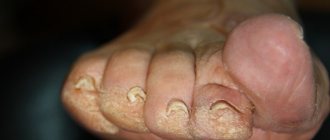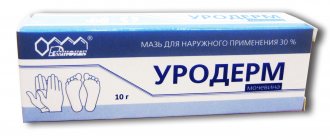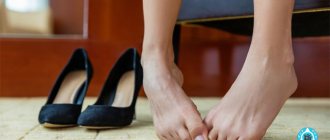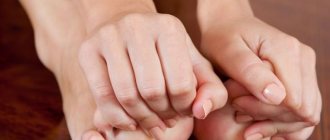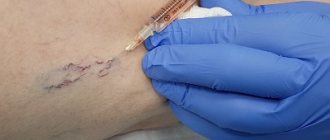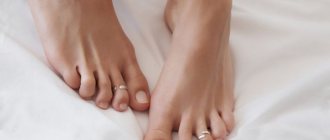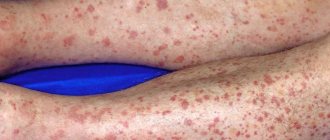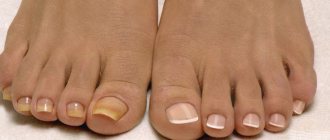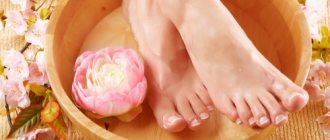The article was prepared by a specialist for informational purposes only. We urge you not to self-medicate. When the first symptoms appear, consult a doctor.
List of modern methods:
- Keratolytic agents
- Plasters for corns
- Pencil for corns
- Japanese socks
- Hardware pedicure
- Cryodestruction
- Laser therapy
- Corn pads
Corns - many people face this problem due to uncomfortable shoes and heavy load on their feet. Women especially often suffer from dry calluses. Most of them definitely have high heels and stilettos in their wardrobe. Incorrect weight distribution in such shoes leads to the formation of corns. Dry calluses can also be caused by various diseases of internal organs and body systems. In this case, they should be treated. Getting rid of corns will only be a temporary solution to the problem. Soon they may appear in the same place again. Flat feet also lead to the formation of dry calluses.
You should not hope that a disease such as corns will go away on its own. Constant loads on the feet will only contribute to its development. In the early stages, corns can be treated at home. However, this does not apply to advanced calluses with a core. Fighting them on your own leads to inflammation. The procedure for removing corns with a rod must be carried out under sterile conditions to avoid introducing infections into the open wound. You need to go to the clinic. And the sooner this happens, the better.
Keratolytic agents: features, composition
Modern medicine offers a large number of ways to solve the problem of corns. You can treat yourself using keratolytic agents. Before using them, you need to make a foot bath.
You can add to it:
- sea salt;
- crushed laundry soap, soda and chamomile infusion;
- 10 ml of ammonia;
- infusion of birch leaves and soda;
- several aspirin tablets;
- table salt;
- oat straw decoction;
- iodine.
Instead of ordinary water, pure herbal decoctions made from nettle, mint, and thyme can be used. They work well on calluses, have a disinfecting effect and help damaged skin recover. Keep your feet in a warm bath with water or broth for at least half an hour. After the corns are carefully treated with pumice or special preparations are used.
What is a keratolytic agent?
You can purchase keratolytic agents at any pharmacy. A doctor's prescription is not required. There is a wide range of keratolytic agents. It can be difficult to stop at just one. Very often, a drug that is effective for one person does not help another person at all. Therefore, you can try several different products and find the right one.
Salicylic acid is usually included in keratolytic agents. It has an antiseptic effect and helps remove the stratum corneum of the epidermis. A corn is a collection of dead cells. This is a protective reaction of the skin to mechanical pressure. Salicylic acid softens such formations. After this, dead skin cells can be easily removed.
Along with salicylic acid, keratolytic agents may include components such as lanolin, petroleum jelly and extracts of various herbs. They also have a softening effect.
It is worth noting that keratolytic agents in the form of ointments and creams are applied strictly to the site of the callus. Do not touch areas of healthy skin. Contact of the product with the mucous membrane should also be avoided. It is recommended to use gloves when treating the sore spot. If the cream gets on the skin of your hands, you should immediately wash them with soap.
The most effective keratolytic agents:
You can purchase such medications at any pharmacy. They have many advantages over other anti-corns remedies.
Advantages of ointments and creams:
- natural ingredients in the composition of the products;
- good results in a short time;
- independent treatment;
- low price.
Flaws:
- it is necessary to protect healthy skin around the corns to avoid wounds and burns;
- allergic reactions due to individual intolerance to the components;
- You must remember to use the cream regularly.
Among the most effective keratolytic agents are the following:
- "Super antimozolin"
This cream is based on carbamide and lactic acid. They moisturize the skin well, the corns soften and can be easily removed with a spatula. “Super anti-callosin” eliminates not only dry calluses, but also unpleasant odor. Due to natural ingredients, the cream has a pleasant aroma of fresh herbs.
- "Bensalitin"
The ointment contains salicylic and benzoic acids. The corns should be treated with it at intervals of several hours, having previously lubricated the skin around the sore spot with Vaseline, and sealed the top with a regular band-aid. For some, this method of treatment may seem too tedious, but as a result, you can get rid of calluses very quickly. The ointment causes irritation if applied to inflamed or wounded skin.
- "Doctor"
The effectiveness of this cream is associated with the active action of the urea included in its composition. It helps fill cells with moisture, and tea tree oil softens the top layer of skin. Among the components of the cream there are extracts of celandine and oak bark. They relieve the skin of the legs from tension and fatigue, relieve inflammation. It is necessary to treat corns once a day, after making a bath.
- "5 days"
This anti-callus paste is suitable not only for the treatment of corns, but also for prevention. Its softening and moisturizing effect is provided by Vaseline and lanolin. The paste is applied for 12 hours. During this time, the active components act on rough skin. After the procedure, the corns can be easily cleaned off with pumice. You can treat the sore spot several times. However, if a burning sensation or other unpleasant sensations occur, you should immediately wash off the paste. Such side effects are possible in case of individual intolerance to the components included in the product.
- "Green Planet"
The cream is recommended for use on corns and rough skin. After it, the skin becomes soft and elastic. All this is thanks to the action of natural oils and lactic acid. Apply Green Planet cream a couple of times a day to problem areas of the skin. It is safe for your hands. It can also be used for prevention, as soon as the skin is restored and the corns are cured. The cream has a pleasant smell.
- Neutrogena
Expensive, but high quality product. Made in Norway. With its help, you can reduce the thickness of the skin on the corns and prevent its occurrence in the future. The non-sticky texture allows you to apply the cream in the morning to moisturize throughout the day. With regular use, the problem of calluses will gradually be solved. The active component in Neutrogena is urea.
- "Namozol-911"
The cream is applied at night; in the morning you can peel off the exfoliated skin. Contains tea tree extract. Has a healing effect. The product is used very sparingly, so one tube can last more than one month even with frequent use.
- Cream against calluses, fungus, and sweating from the Crown of Siberia brand
This product belongs to natural cosmetics and contains horsetail and fly agaric extract. Thanks to fragrances and essential oils, it is very aromatic. You need to apply cream to your feet 2 times a day. After this, you should wait until the product is completely absorbed. It not only softens corns, but also promotes wound healing. After two weeks, the problem of dry calluses will be completely resolved.
- Corn tincture "Gehwol"
Many pedicurists choose this product for good reason. The tincture has a strong penetrating effect. Therefore, during a hardware pedicure, it quickly softens rough areas of the skin. At home, the tincture must be used at least 2 times within 4 days. A convenient brush makes it easy to apply the product exactly to the corns. It is recommended to use a patch to protect the surrounding healthy skin.
- Cream against corns with snake oil "TianDe"
Chinese cosmetics have become popular recently. Many note that it has a good effect on the skin and the body as a whole. Snake oil cream is no exception. It is suitable for daily use and helps quickly remove corns. Has an antibacterial and healing effect.
On the subject: How to remove corns at home?
Avoid serious problems
A wide range of dermatoses develops in patients with diabetes mellitus. A number of pathologies are harbingers of this disease, others are a consequence. In total, up to 30 types of dermatoses with different clinical pictures are registered in diabetes mellitus.
All of the above diseases require professional and long-term treatment. It is recommended not to let your feet get into a condition that would require going to a hospital or clinic. It is necessary to regularly engage in the prevention of foot skin diseases. To do this you need:
- take care of your feet using products recommended by a cosmetologist;
- keep feet clean and dry;
- wipe the skin between the toes well after hygiene procedures;
- change socks twice a day, do not use synthetic shoes;
- wear only personal items.
People with chronic diseases are recommended to visit a podiatrist once every six months to receive professional care procedures.
Plasters for corns
The advantages of this treatment method:
- ease and simplicity of use of the patch;
- relief from pain after just one use;
- After a week, the corns completely disappear.
Treatment with a patch has virtually no disadvantages. You just need to change it regularly. Allergic reactions occur much less frequently than when using creams and ointments. However, in some cases, irritation is possible from the patch.
The most popular means are:
- "Compeed"
Compeed is one of the most well-known companies that produces quality patches to combat corns. They have important advantages over similar products from other brands.
Firstly, the Compeed patch is suitable for use for several days. It is tightly fixed and will not come off, even if you move actively.
Secondly, the patch relieves pain by reducing the mechanical impact on the skin. After a few hours, you will be able to forget about the discomfort that corns cause when moving.
Thirdly, the product moisturizes the skin no worse than creams and ointments with a greasy and nourishing texture.
Before use, you need to make a foot bath. After this, carefully and carefully treat the sore area with a nail file or pumice stone, removing the very top layer of skin, and dry with a towel. Before sticking the patch on, warm it with your hands. Attach only to the place of the corn. Otherwise, the patch may cause severe burns. On the leg, the patch needs to be warmed again by rubbing it with your hands to enhance its effect. Repeat the procedure until the corns disappear completely. The company Compeed produces plasters for calluses between the toes. They are very convenient as they are designed specifically for hard-to-reach places.
- "Shuyangxuan"
This patch belongs to Chinese traditional medicine. It must be used for 6 days. During this time, the skin at the site of the corns softens. Over the next 10-15 days, the dead cells gradually fall off. Under the influence of the patch, the skin turns red. But don't worry about this. This reaction means that the active components of the patch act on rough skin.
Before using the patch, the corns need to be steamed. After this, stick it on dry skin and leave for a day. After 24 hours, the procedure is repeated. During treatment, it is better to wear socks and not wear open shoes.
- "Salipod"
This patch has an antiseptic and keratolytic effect. It contains salicylic acid. Its action ensures softening of the skin. Due to this, the active components penetrate deep inside. The patch has an antimicrobial effect, protecting against bacteria on the surface and preventing the development of fungal infections. "Salipod" contains sulfur, which dries out the skin.
This product should not be used by pregnant women, children, or people with kidney disease. For some it causes itching and burning.
The patch is applied for two days. As with other products, you first need to make a foot bath. Four applications are usually sufficient to completely remove the corn. You should not use the patch if your skin has noticeable cracks or wounds.
- "Urgo"
Another effective keratolytic agent in the form of a patch. It is made from wheat germ oil. Enriched with vitamins, the product has a positive effect on the skin of the feet and restores it. The advantage of this company’s patches is the presence of a special gasket. It protects the skin around the corns. The patch does not stick to the sore spot, so it will not cause pain. There are two types: protective and callus. The first is used both for the prevention and removal of corns. Corn patch is used only for their active treatment.
Main skin problems on the feet
A podiatrist is regularly contacted with the following foot skin pathologies:
- calluses;
- cracks of different depths;
- dry skin;
- hyperhidrosis;
- corns;
- hyperkeratosis.
The specialist’s task is not only to identify the presence of pathology and select a method for eliminating it, but also to determine the causes of its occurrence - this will help carry out prevention and prevent the occurrence of pathologies in the future.
Pencils
You can always take this remedy for corns with you. Compact, it does not take up much space and can be used in any situation. You should definitely take a pencil with you when your shoes are new. It is unknown whether she will rub her feet or press. But if such a situation arises, it will be possible to prevent the appearance and development of corns.
Pencil from WARTNER
Among pencils, the WARTNER applicator pen for removing dry calluses is very popular. Its effectiveness is due to TCA gel. After application, it dries in 15 minutes and penetrates deeply into rough skin. You should avoid getting it on the area around the corns. The course lasts 4 days. The gel should be applied morning and evening. After complete drying, you can remove dead skin cells under running hot water. Before use, you should carefully read the instructions to avoid side effects.
Pencil from Compeed
Since it is better to prevent the appearance of corns than to treat them, you should pay attention to the Compeed pencil. It has managed to establish itself as a manufacturer of quality anti-callus products. The pencil does not leave marks, so you can safely wear any shoes, even if they are open. This product takes care of the skin of the feet, reducing friction and pressure. Therefore, if you use the Compeed pencil in advance, dry calluses can be avoided.
Japanese socks
This new and fashionable remedy for getting rid of corns has already been tried by many lovers of high-heeled shoes and stilettos. Socks are convenient when you don’t have time to constantly take baths and apply cream or apply a patch.
They contain extracts of medicinal herbs: chamomile, sage, burdock. Many properties are due to the presence of lactic acid, lemon, and citrus oil.
The socks affect the entire foot, softening the skin. She becomes rude from tight and uncomfortable shoes. This skin condition can cause the development of fungal diseases, cracks and unpleasant odors. With the help of socks you can get rid of corns and prevent the occurrence of other problems. They improve blood circulation and restore the skin, although they have a sharp, specific smell. By eliminating dry calluses, the socks have an antifungal and exfoliating effect. It is especially good to use them after a hard day on your feet. The product relieves swelling and has a relaxing effect.
Baby Foot Socks
Baby Foot socks are easy to use. They need to be removed from the packaging and the top layer cut off along the line. Then the socks are put on and securely fastened with the strips included in the kit. Within an hour, the rough skin is destroyed layer by layer. Then the socks should be removed and the feet should be thoroughly washed with soap and warm water. You can completely get rid of corns in a few days. To do this, you should regularly brush your feet. During the procedure, you can not be distracted from your daily activities, but to increase efficiency, it is better to relax and not walk. In addition, there is a danger of slipping if you move too actively in your socks.
Each procedure requires a new pair. Repeated use may spread bacteria and reduce effectiveness. The next time you can put on socks no earlier than two weeks after the first use. Usually you can forget about corns for several months.
Japanese socks are not the cheapest way to get rid of dry calluses. However, compared to other means, it acts quickly, and the effect lasts for a long time.
Reasons for appearance
On healthy areas of the skin, affected areas are highlighted in yellow. Causes of dry calluses on the feet:
- Lack of vitamin A in the body.
- Poor quality or uncomfortable shoes.
- Pathological diseases of the feet. These include protruding bones, flat feet, growths, and rheumatoid arthritis. Even in comfortable shoes made of natural materials, sore feet are subjected to intense friction, which is why roughness forms.
- Excess weight provokes increased stress on the feet, resulting in corns.
- Endocrine disruptions in the body, varicose veins, mycosis - contribute to disruption of blood supply, epithelial layers and healthy tissues die, as a result of which large calluses appear on the soles.
- Dermatological diseases - keratoderma, fungus, irritation from artificial tissues.
Prolonged wearing of shoes, hard lasts or high heels can provoke the development of the problem. Dermatologists recommend taking off your shoes at least 2-3 times a day, allowing your feet to rest. If possible, it is recommended to carry out therapeutic procedures of walking barefoot on grass or sand, at least 2 hours a week.
Hardware pedicure
If self-treatment does not produce visible results within several weeks, you should contact a specialist. The most gentle method is hardware pedicure. Many ladies, who are not even concerned about the problem of corns, regularly do this procedure in the salon, because it is several hours of pleasure, and the result is smooth and soft feet.
To get rid of dry calluses, you should contact a hardware pedicure specialist. This method allows you to remove corns as deeply as possible. The device also drills out calluses with a rod. It is almost impossible to get rid of them on your own, especially in advanced cases. During the procedure there is no discomfort, much less pain.
First of all, the feet are treated with a disinfectant. Then the corns are cleaned off using a fine-grained and coarse-grained drill.
When performing a hardware pedicure, the possibility of infection is excluded. An experienced master always works with gloves. The result of the procedure depends on the device. Good models provide complete removal of corns. If you do a hardware pedicure regularly, then the problem of dry calluses will no longer affect your feet.
If you have fungus on your feet, what should you do?
Have you ever tried to get rid of foot and nail fungus on your own? If yes, then you are familiar with the feeling of unbearable itching near the nail, burning between the fingers, and peeling of the skin.
However, this is only a small part of the symptoms of the initial stage of onychomycosis. According to statistics, about 30% of people in Russia suffer from fungal infections of the feet and nails, and the majority consider fungus only a cosmetic defect that does not pose a serious health hazard.
A fungus is an infectious lesion of the skin, a microorganism that parasitizes the human body, resulting in the development of lesions of the skin, its appendages and internal organs.
If you encounter this unpleasant problem, you should definitely consult a doctor. As a rule, a dermatologist treats fungal infections. After examining the patient, a thorough examination and establishing the correct diagnosis, the doctor prescribes adequate treatment. Most often, specialists prescribe external agents and tablet antifungal drugs. The dosage and duration of treatment are selected individually.
You may be interested in: “Elastic body. How to make your body elastic and toned in 10 minutes"
Cryodestruction
Liquid nitrogen is used in medicine to remove warts, scars and corns. Among all the methods to get rid of dry calluses, cryodestruction or cryotherapy is considered the most painful. After it, the skin takes a long time to recover and requires careful care. In addition, removing corns with liquid nitrogen is an expensive procedure.
However, despite all the disadvantages, cryotherapy also has advantages. So, there is no blood involved, and it takes very little time, which is important for many. Self-treatment requires constant repetition of procedures; you need to carefully put on your shoes. After cryodestruction there are no traces or scars left. The risk that corns will form again in the same place is minimal. For those for whom anesthesia is contraindicated, this is a very successful option for surgical removal of dry calluses. The procedure does not require pain relief. Although because of this you will have to endure unpleasant sensations.
Liquid nitrogen has virtually no contraindications, but it can only be used on a small area of skin. If the corns are large or several calluses are located nearby, cryotherapy will not be suitable in this case. Recovery will be too long and difficult.
What is it: description and photo
Corns, or dry calluses, are compactions of the surface layer of the skin that occur in areas of increased production of epidermal cells. The accumulation and growth of skin compactions occurs as a result of damage to the skin and subcutaneous tissues.
Most often, changes in skin integrity are caused by compression resulting from improper distribution of load and mechanical irritation. Below is a photo of the disease.
Laser therapy
Getting rid of corns using a laser is a painless and effective method. The beam acts strictly on the affected areas. Thanks to this, the healthy skin around the corns is not affected. At the same time, the disinfecting effect of the laser beam protects against infection by various infections and from pathogenic bacteria entering the wound.
After the procedure there is no need for special foot care. You can continue to do your usual activities without experiencing any more pain and discomfort caused by dry calluses.
Unlike cryodestruction, the effect of the laser beam on the skin is not noticeable. During the procedure, the patient does not experience any sensations. This method is suitable for those who have a low pain threshold. Laser therapy only needs to be done once. Therefore, it is better to spend money on this expensive procedure than to constantly purchase keratolytic products for home treatment.
How to remove corns at home - folk remedies
I have compiled a list of the most popular traditional medicine techniques into a table. They are safe and easy to prepare.
| Name | How to use |
| Dandelion | Apply juice from flowers and stems to affected areas |
| Raw potatoes | Place the paste on the corns, wrap it in gauze, and keep it there until the morning. |
| Onion | Grind it on a grater and apply it to the corns as a compress. |
| Garlic and lard | Grind a piece of salted lard and a clove of garlic through a meat grinder, secure with polyethylene and a bandage. |
| Aloe | Cut a 3 cm long sheet in half and apply the wet side to the skin. Wrap with film and put on a sock. |
| Celandine | Prepare a decoction, soak gauze in it, wrap your feet, and keep it until the morning. |
| Olive oil | Dampen the cotton slips and place them on your feet. Protect the top with plastic and another pair of socks. Remove after 2 hours. |
| Lemon | Secure the freshly cut slices to the keratinized areas overnight. |
| Propolis | Grind the fresh product (2 g), dilute it in a teaspoon of vodka, soak napkins and wrap the corns. |
Pads against corns: proper prevention is the best protection
Coping with a disease at an early stage is easier than when it is already advanced. But it’s even easier to prevent it from appearing. Constant prevention will help avoid the formation of dry calluses. To do this, you need to carefully consider the choice of shoes; women alternate stilettos and heels with ballet flats and moccasins. Apply moisturizer daily and have regular pedicures.
If you have to constantly wear high-heeled shoes, you need to use special silicone pads. They are designed for reusable use. It is recommended to wash the pads frequently with water and sprinkle with talcum powder before use. Their main purpose is to distribute weight evenly, which eases the load on the feet, thus protecting against the appearance of corns. They can be presented in the form of insoles, half-insoles and inserts. These types of pads differ in size. For closed shoes, you can choose insoles or semi-insoles, but inserts are suitable for open women's shoes or sandals. It is also worth considering where on the foot corns most often form. The inserts protect the skin under your toes; for a better effect, you can opt for the insole.
Author of the article:
Kuzmina Vera Valerievna |
Endocrinologist, nutritionist Education: Diploma of the Russian State Medical University named after. N.I. Pirogov, specialty “General Medicine” (2004). Residency at the Moscow State Medical and Dental University, diploma in Endocrinology (2006). Our authors
Our specialists
- Kiani Ali
Candidate of Medical Sciences, laser medicine specialist, dermatocosmetologist.
Sign up
- Stepanova Inna Igorevna
Candidate of Medical Sciences, maxillofacial surgeon, specialist in laser medicine.
Sign up
- Fedotova Marina Andreevna
Surgeon, dermatocosmetologist, laser medicine specialist
Sign up
- Popovkin Pavel Sergeevich
Surgeon, oncologist, laser medicine specialist.
Sign up
